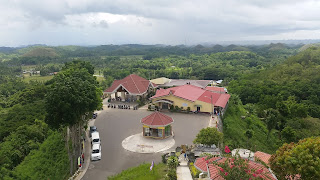PANGLAO ISLAND, BOHOL
Municipality of Panglao - is a 4th class municipality in the province of Bohol, Philippines. According to the 2015 census, it has a population of 33,553 people. It is one of two municipalities that make up Panglao Island. Panglao is known for its diving locations and tourist resorts.
The name Panglao may have come from its former name Panglawod, meaning "to the open sea" or derived from the word panggaw, referring to a fishing implement used by locals. Panglao Island International Airport will serve as Bohol's primary airport replacing Tagbilaran Airport. It is expected to be commercially available in August 2018.
History
Well before the Spanish colonization, the area was already long visited by Chinese and other Asian traders, as evinced by archaeological finds of Tang, Song and Ming dynasty porcelain and trade wares. Panglao flourished during the rule of the Dapitan kingdom, but raids by Moluccans and conquest by Ternate resulted in periods of depopulation when its population fled mostly to Panay and Mindanao, including Dapitan.
During the Spanish rule, a Jesuit mission post was established, that in 1782 was formed into a parish, known as La Iglesia de San Agustin de Panglawod. In 1803, the town was officially made into a municipality. The Panglao watchtower was built in 1851. The 5-storey octagonal tower is the tallest of its kind in the Philippines but suffers from neglect.
Tourism
The primary tourist attraction of Panglao are its white sandy beaches, of which Alona Beach is the most famous and most developed. Alona Beach is about 1,500 metres long, lined with palm trees, resorts and shops. However, it has drawn critisms for its unrestrained development that ignored municipal development policies, warning against overcrowding and Alona to lose its paradise-like image. Therefore, the municipal, provincial and national governments are ploughing ahead with a plan to build a new international airport on Panglao Island, with the final approach path directly over Alona Beach. Currently plan is to be operational at the end of 2018. Other beaches include Bagobo, Bolod, Danao, Doljo and Momo Beaches.
Panglao is renowned for snorkeling and dive sites such as Doljo Beach, Garden Eels, Arco Point, Kalipayan, Napaling and Puntod. The island's southern portion is ringed with reefs that are relatively narrow and shallow (5 to 6 metres or 16ft to 20ft) with submarine cliffs plunging to depths of 33 to 56 metres. Tours can readily be arranged to further dive sites, including Balicasag and Pamilacan, Bohol.
ALONA BEACH
One of the most famous tourist spots in the province of Bohol, because of its white sand and the rocky cliffs. The beach is situated on the Panglao Island, 20 kilometers from Tagbilaran City and accessible by a sealed road. Compared to other locations, the beach is rather small as it spans less than one kilometer of white powder sand surrounded by a rocky cliffs.
The beach is located near a "house" reef, where corals and colorful fishes can be seen even without diving equipment. It is a popular diving and snorkeling spot.
BOHOL BEE FARM
The Bohol Bee Farm is a very cozy and relaxing place on Panglao Island. Owner and Chef Vicky Wallace prepares delicious meals from organically-grown vegetables on her farm - from squash muffins, vegetable lasagna to her specially-brewed coffee from roasted corn and wild berries. She rents her chalet-styled home to guests who want to enjoy the peace and serenity of having the entire farm to themselves...
This is certainly a place apart: not only is it a wonderful relaxing place for visitors, it also tries to contribute to the local community and the environment.
Bohol Bee Farm is geared towards encouraging and inspiring our farmers to practice Organic Farming. They don't need to spend for costly conventional fertilizers, nor use harmful pesticides in their farms. Basic composting and companion planting are alternatives we offer in their stead.
Facilities: Swimming Pool / Sea View / Garden / Restaurant / Wi-Fi / Scuba Diving / Transfer Service
Address / Contact: Dao, Dauis, Panglao Island, Bohol, Philippines.
Phone: +68 38 502 2288
+63 917 304 1491
Email: vicky.beefarm@gmail.com




































































